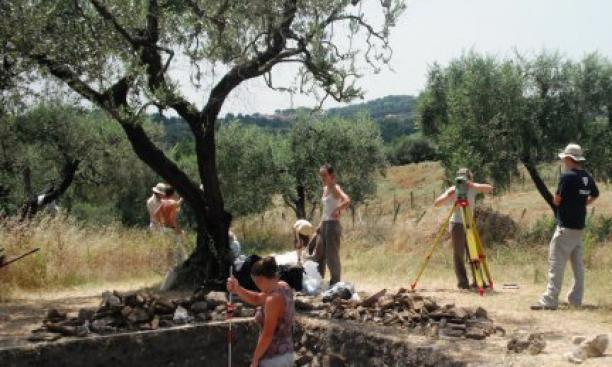
 |
Caroline Clark ’12, behind tripod, worked as a surveyor at an archaeological excavation in Capena, Italy. (Courtesy Caroline Clark ’12) |
By Katy Pinke ’10
Many undergraduates spend their summer months paving paths to their future, but few do so by venturing into the past. Caroline Clark ’12 was one of those few last summer, working as the sole surveyor of an archaeological excavation site in Capena, Italy.
Clark was the 2009 recipient of the Charles A. Steele Prize, given each year to one undergraduate majoring in classics for the purpose of summer exploration. "Unlike other fields of study, the thing about classics is you aren't often given the chance to 'see for yourself,' " she explains. "What excited me about the prospect of excavation was that as opposed to literature or word-of-mouth, I could interact with a real, tangible piece of history."
The excavation began in 2005. Through the use of ground imagery, researchers surmised that the site might contain treasures from the Roman Republic. Capena today is an area composed of farmland and little else, but it was once a very busy, prosperous suburb of Rome.
The dig was directed by Roman Roth and Carrie Roth-Murray, a married couple of archaeologists who completed their postdoctoral research at Cambridge. Eight postdoctoral researchers worked at the site, along with four undergraduate classics majors. Clark was the sole Princetonian.
Clark holds a piece of Roman pottery from 300 B.C., stamped with the potter's trademark. (Courtesy Caroline Clark ’12) |
According to Clark, "a dig evolves with time, and responsibilities on site evolve too. We go through different time periods and see different kinds of patterns." When she joined the team at the beginning of June, excavators had been uncovering artifacts from the middle ages for two years, and they were on the brink of discovering ruins from the Roman period. That transition made the role of a surveyor particularly important.
After a week of training under surveyor Helen Woodhouse, a Ph.D. on site, Clark was left to do all of the surveying herself. She used an imaging tool called the Leica Total Station to plan points of expansion in the excavation trenches. "I loved it a lot," she says. "It was very similar to civil engineering."
Over the course of the summer, Clark and the team found artifacts from as early as 300 B.C. This was Clark's first time learning about the complexity of dating in archaeology. She was faced with the challenge of discerning time periods based on soil texture, color, and behavior in reaction to movement. Different types of soil reflect geological events that have transpired at different points in the earth's history.
The luckiest discovery was that of two Roman coins. The team was in the midst of deciphering the Latin inscription and the identity of the emperor on each coin when Clark left to return to Princeton.
"The coolest thing for me was knowing that I was one of the first people in 2,000 years to touch these coins, and to somehow be connected to those who used them in the past." After her experience this summer, Clark is considering a career in archaeology.
